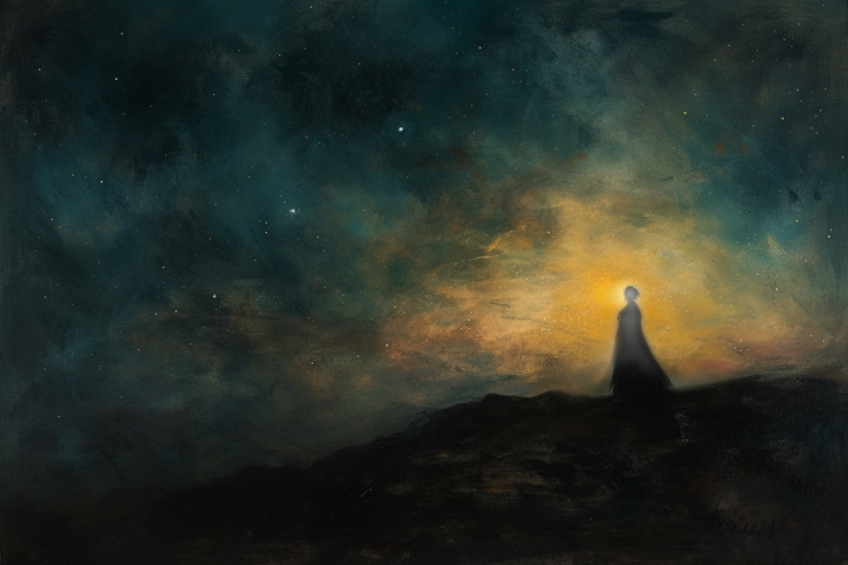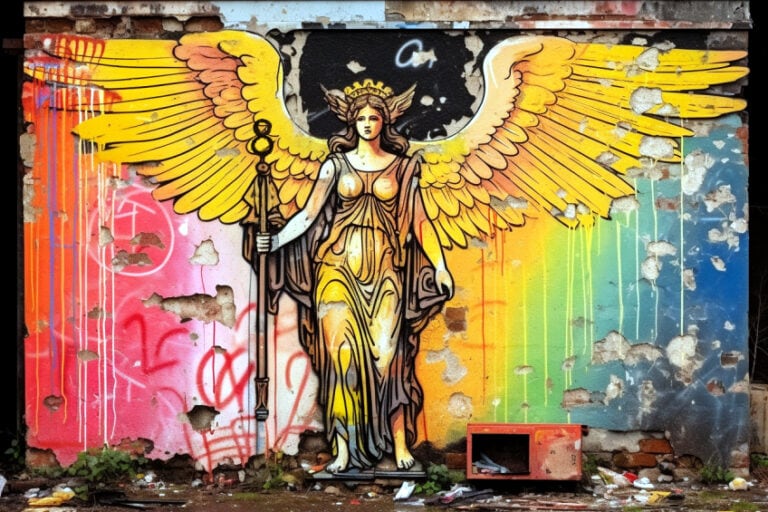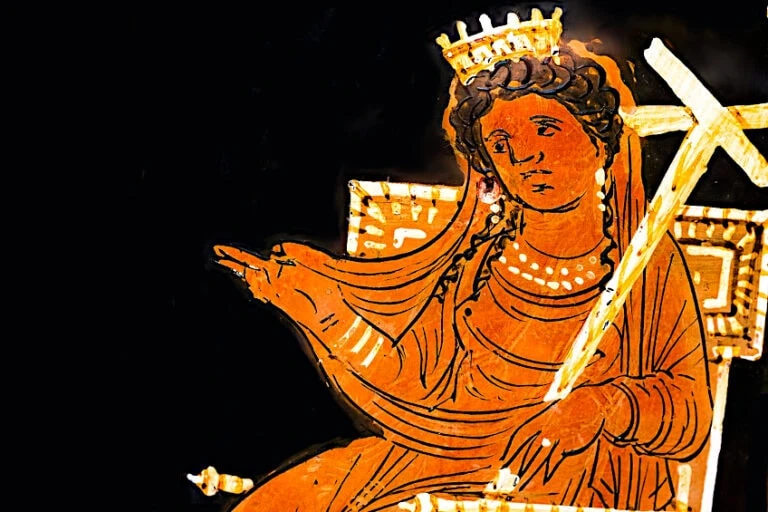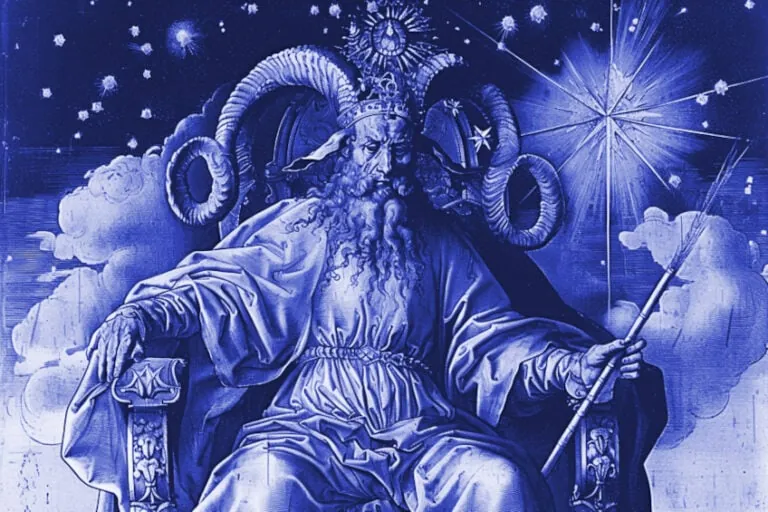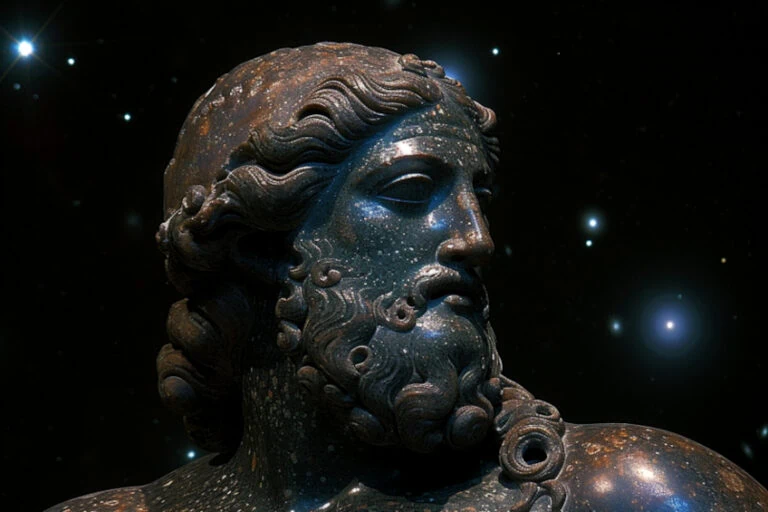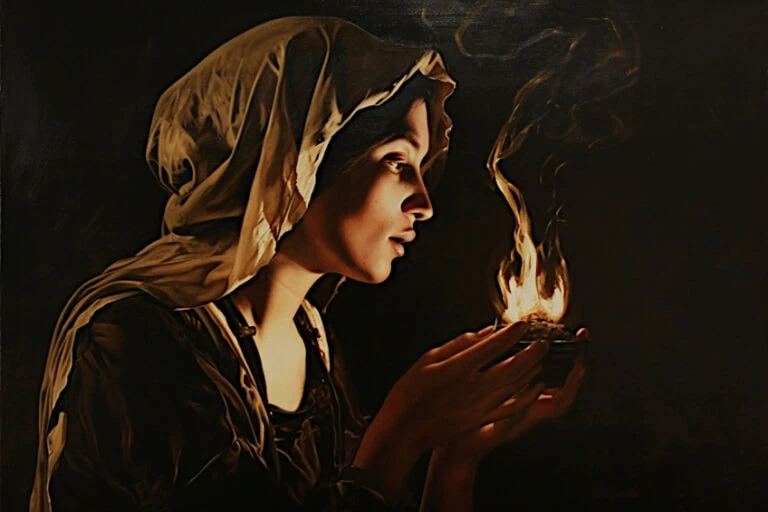Greek Goddess Eos – Gentle Daybreak Personified
The Greek goddess Eos is a beloved figure in Greek mythology. The manifestation of the dawn is a favored figure for works of art thanks to her numerous love affairs. The Titaness Eos has played a role in the major conflicts of Greek mythology such as the Titanomachy, the Trojan War, and the Gigantomachy. Despite this and her ancient origins, Eos is a quiet figure on the ancient Greek cult scene, and we hope that you will join us in exploring this unique goddess in the article below.
Contents
The Personification of the Dawn: Eos
| Name | Eos |
| Gender | Female |
| God of | The dawn personified |
| Personality | Passionate, determined, and loving |
| Symbols | Saffron cloak, jugs of dew, tiara, and cicadas |
| Consorts | Astraeus, Tithonus, Cephalus, Orion, and Cleitus |
| Children | Astraea, the Astra, the Anemoi, Memnon, Emathion, and Phaethon |
| Parents | Hyperion and Theia |
The Greek goddess Eos was a Titan of Greek mythology believed to be the personification of the dawn. Eos would ride her chariot from the great river Oceanus, crossing the sky before her brother the Titan of the sun Helios, closing the night by bringing light back to the ancient Greek sky.
The lovely and lascivious Eos was a popular figure of Greek poetry and literature, but also boasts ancient roots stretching to the Proto-Indo-European eras. The Romans identified Eos with their goddess Aurora and their attributes and mythologies closely converge.
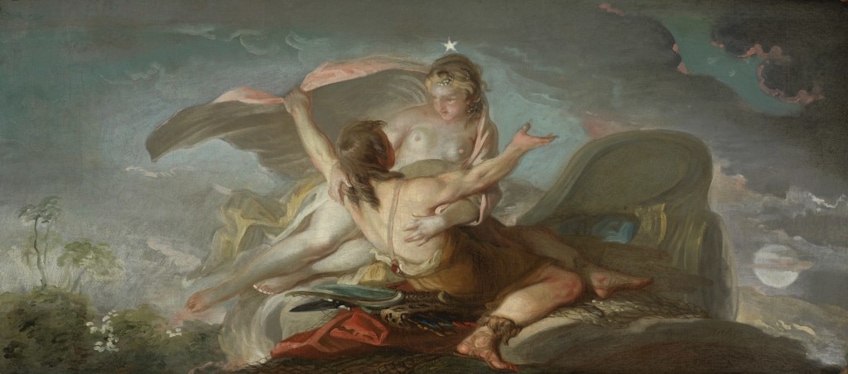 Daybreak by Gabriel Jacques de Saint-Aubin (c. 1760); Gabriel de Saint-Aubin, Public domain, via Wikimedia Commons
Daybreak by Gabriel Jacques de Saint-Aubin (c. 1760); Gabriel de Saint-Aubin, Public domain, via Wikimedia Commons
Background of Early-Born Eos
The Greek goddess of dawn has old origins, though she is largely sidelined in the Ancient Greek cult traditions. Eos remains a strong presence in literary and artistic references to her storied dominant pursuit and kidnappings of handsome mortal men.
Associations of Eos
Eos name varies locally, including dialectic alternatives like Heṓs, Auṓs, and Aṓs. Her Latin alternative is found in the goddess Aurora, and she holds many epithets such as’ ērigéneis’ which means “early-born”, and descriptors like ‘rhododáktylos’, ‘chrysopáchys’, and ‘krokópeplos’, meaning “rosy-fingered”, “golden-armed” and “saffron-robed” respectively.
The Greek goddess Eos, alongside her siblings and Zeus, are the only gods with clear Proto-Indo-European roots.
Eos is commonly held as one of the many successors of the Proto-Indo-European dawn goddess. Her name, being that of the dawn, has been reconstructed from *h₂éwsōs, deriving from a root word meaning “to shine”, “glow red”, “ or “a flame”. This goddess of the dawn has been presumed highly important to the culture, as her characterizations have survived consistently in the customs following them, as well as the centrality of a linked goddess, Ushas, in the ancient Rig Veda. Eos holds the precursor dawn-goddess’ associations with saffron-yellows, golds, and reds, as well as being the horse/ox driving opener of heaven’s gates and reluctant to bring the dawn.
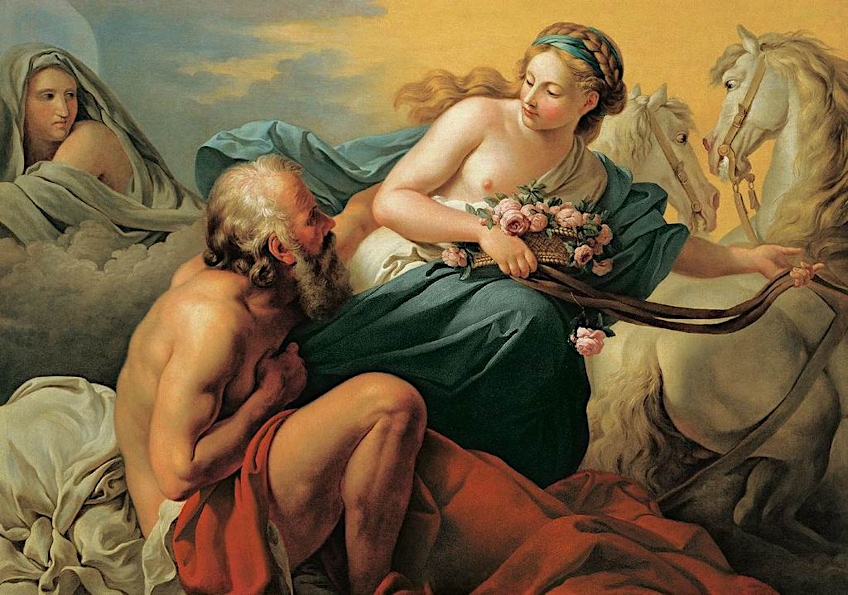 Aurora’s (Eos’) Take Off by Louis Jean Francois Lagrenée (18th Century); Louis-Jean-François Lagrenée, Public domain, via Wikimedia Commons
Aurora’s (Eos’) Take Off by Louis Jean Francois Lagrenée (18th Century); Louis-Jean-François Lagrenée, Public domain, via Wikimedia Commons
Eos also shares many traits and associations with goddesses like the Greek goddess of love Aphrodite, who allegedly cursed her with her frequent infatuations, and the Greek goddess of the day Hemera, with whom she is sometimes referred to interchangeably.
Family of the Dawn Titan
The Titan Eos was the daughter of the god Hyperion and goddess Theia, two Titan children of Gaia and Uranus who were associated with heavenly light. The Titan pair of Hyperion and Theia are her commonly accepted sires, however, Ovid and Valerius Flaccus’ works sometimes refer to her as a daughter of Pallas. Her siblings include the personifications of the sun and moon, the Titans Helios and Selene respectively.
Eos’ husband is Astraeus, one of the sons of the Titan Crius and the goddess Eurybia.
By him, she is considered the mother of the goddess Astraea, the Astra, the directional winds also known as the Anemoi. Aside from her husband, Eos is a goddess embroiled in love affairs, usually among mortal men. Some of these include the mortals Tithonus, Cephalus, Orion, and Cleitus. With the Trojan prince Tithonus, she is mother to Memnon, the king of Aethiopia, and his brother Emathion, and sometimes Phaethon. Phaethon is also sometimes Eos’ son by the Athenian prince Cephalus, alongside Hesperus, and Aoös.
The Greek Goddess Eos’ Significance
Eos is afforded one of the oldest places in the ancient Greek pantheon, with much of her characterization seeming to predate the pantheon altogether. As one of those who came before the Olympians, known colloquially if not by direct designation as a Titan, she and her family embodied the older, fundamental cosmic and natural forces that made up the world. Eos as the dawn was the ender of night and bringer of light to the ancient Greeks. She opened the gates for her brother Helios, the sun personified, to begin his journey across the sky each day. She also birthed the stars, the winds, and several notable demi-god figures of Greek myth.
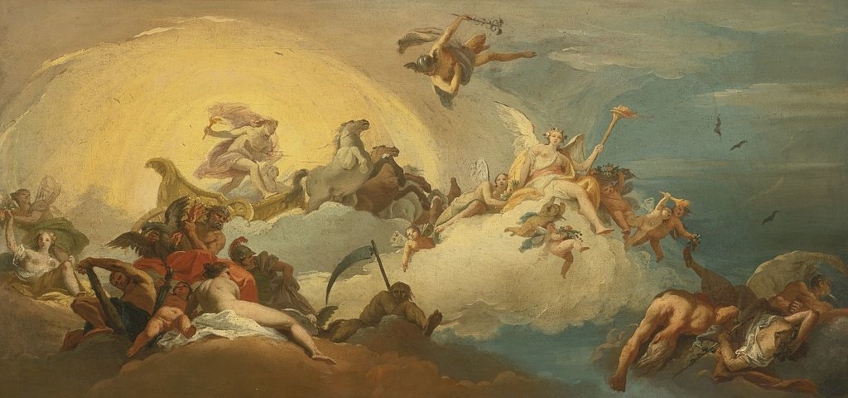 Aurora (Eos) with Apollo Driving the Sun Chariot by Costantino Cedini (before 1811); Costantino Cedini, Public domain, via Wikimedia Commons
Aurora (Eos) with Apollo Driving the Sun Chariot by Costantino Cedini (before 1811); Costantino Cedini, Public domain, via Wikimedia Commons
Despite her ancient origins, Eos held little importance in terms of ancient Greek cult life, however, she was a common feature of many artistic mediums. Eos was held as a figure of deep love in Greek literature, whether in sexual, obsessive, devoted, or familial love, she was a goddess with a rich emotional world to reference.
Recipients of her love generally ended in tragedy, however, none could deny the depths of her feelings and the gripping subject matter they created for art and literature.
The Attitudes and Attributes of Eos
Eos was most often characterized by her role as a pursuer of handsome mortal men. A radiant, sexual, and love-struck goddess, whether by her own appetite or cursed, was a favorite of poets and writers to refer to. Her popularity in literature meant a vast array of characterizations across writers, from cruelly obsessed to helplessly adoring, and fickle lover to faithful companion.
She could be upheld as a paragon of deeply ardent love, or used as a warning of the dangers of mortals catching a god’s eye.
In all ways, she is a being of deep passions and emotions, with a dominant and determined spirit that could easily be used for help or harm. The depths of her love and devotion are also extended to her role as a mother, with her grief and laments at her lover’s and mortal sons’ sad fates a common element of her mentions. Her passionate grievances were enough to move Zeus on more than one occasion. Eos wields a depth of emotion and freedoms uncommon amongst women and even goddesses of the ancient Greek ages.
Eos’ Appearance and Symbols
Eos was a beautiful goddess, radiant as befitting her status as dawn personified. She is often depicted driving her chariot, much like her siblings Helios, the sun god, and Selene, the moon goddess. Unlike her siblings, the rosy-fingered, golden-robbed goddess is depicted possessing a pair of wings she alights on. Her saffron robes are a staple of her depictions in literature and art, and her descriptions often proclaim her gentle beauty, with her “rosy” or “golden” arms and fingers, as well as having “snow-white” eyelids and rosy cheeks.
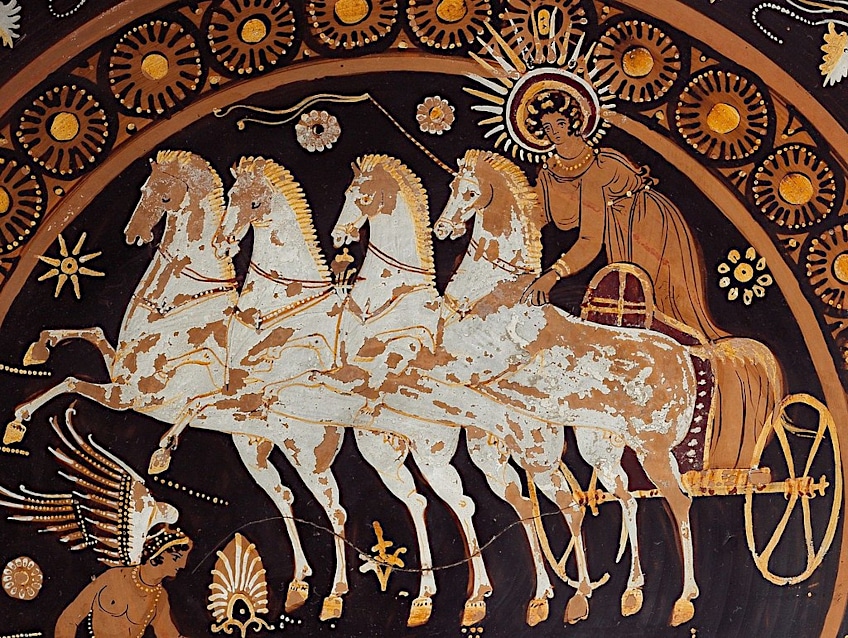 Terracotta Lekanis with a depiction of Eos driving her chariot (late 4th Century BCE); Unknown, Deiadameian (cropped detail), CC0, via Wikimedia Commons
Terracotta Lekanis with a depiction of Eos driving her chariot (late 4th Century BCE); Unknown, Deiadameian (cropped detail), CC0, via Wikimedia Commons
As the dawn personified she has little concrete celestial symbols depicted; however, alongside her yellow-gold robes, she is often pictured with the horses, Lampus and Phathon, who pull her chariot, tiaras, and flowers. Through her descriptions, she also has associations with saffron, gold, and rosy colors like red and pink. She also has connections to cicadas and Memnonian birds from her lover Tithonus and her son Memnon’s men, who were turned into the creatures respectively.
In art, she is sometimes depicted with a jug or vase she supposedly uses to pour morning dew.
The Dawn Titans’ Worship and Influence
Despite the suggested age and status of her divine Proto-Indo-European predecessor, Eos is largely sidelined in the ancient Greek cult. Greek cults often worshiped in relation to what the cult subject would or could provide to their daily lives, whether that be wisdom, protection, or appeasement of the wild forces the goddess embodied.
Eos as the dawn had little bearing in the light of utility, despite her popularity in art culture, and no evidence remains she enjoyed any major cult following.
She may have been worshiped alongside other celestial and light gods, like her siblings the sun and moon, or in relation to her more prominent children or role as a lover. What little we know concretely comes from a mention of her receiving libations at Athens, as well as a writing from Ovid, who as the goddess describes her shrines being ‘the rarest’ in the world, and herself ‘the least of all goddesses’. This mention may imply that Ovid knew of at least two shrines of Eos, but it is largely speculation.
Eos’ Roles in Literature
The goddess Eos is favored by many poets and artists in reference to her radiance and storied romances. Besides her lovelorn image, the goddess does play a vital role in ancient Greek cosmogony as the personification of the dawn and mother to the winds and stars. She is also the divine mother of mortals such as the King Memnon, who went toe to toe with the great hero Achilles during the Trojan War.
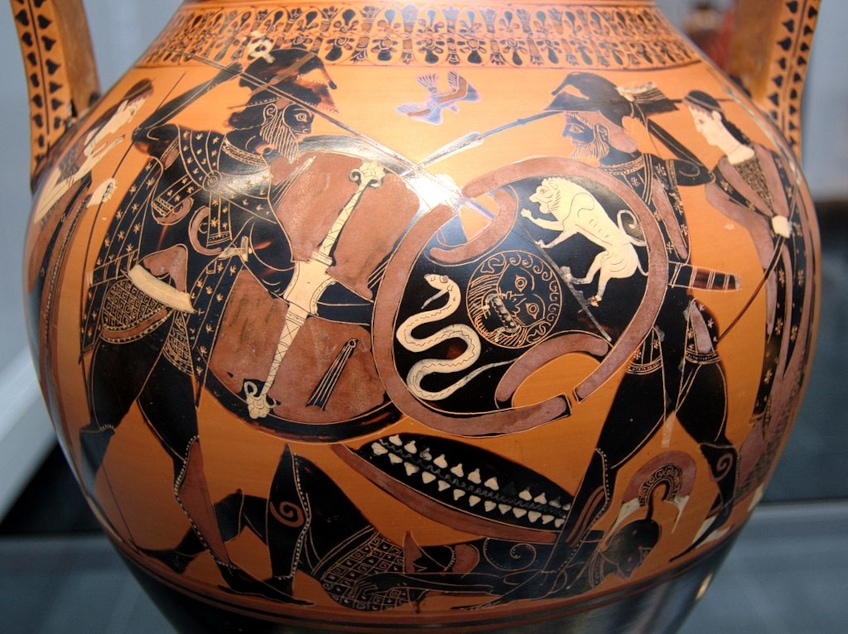 Attic black-figure amphora with a depiction of Achilles and Memnon in battle flanked by their mothers Thetis and Eos (c. 510 BCE); Staatliche Antikensammlungen, Public domain, via Wikimedia Commons
Attic black-figure amphora with a depiction of Achilles and Memnon in battle flanked by their mothers Thetis and Eos (c. 510 BCE); Staatliche Antikensammlungen, Public domain, via Wikimedia Commons
The Dawn Personified
Eos is the bringer of the dawn to the ancient Greeks, riding her luminous chariot across the sky with her “rosy” arms and fingers, coloring the sky with light and chasing the dark away. She is the one who opens wide the gates so that her brother, the sun-personified Helios, can begin his journey across the skies. Some say she rides alongside him, but she returns to her dwellings in Oceanus to rise from the great river again in the East come the next morning. Her retinue is said to include her herald and son Eosphorus and the Horai, who are the goddesses of the hours of the day.
Her power as the dawn and bringer of light to mankind has been featured in several myths. In Homer’s Odyssey (8th century BCE) Athena beseeches her to delay in kitting her steeds to begin her journey bringing light to the earth. She does this so that Odysseus and Penelope could have more time to enjoy their reunion.
In a myth regarding the Gigantomachy, Eos and her siblings play a small but pivotal role. The conflict between Gaia and her sons the Giants against the Olympian gods, with the cosmos as the prize, is a tale reconstructed across many works. One work details that, in response to a prophecy that defeating the Giants would require the assistance of a mortal, Gaia seeks to make the Giants invulnerable using a specific plant. Zeus prevents this by forbidding Eos and her siblings Helios and Selene from shining their light on the earth, and taking all of the plant for himself, leaving the Giants without its protection.
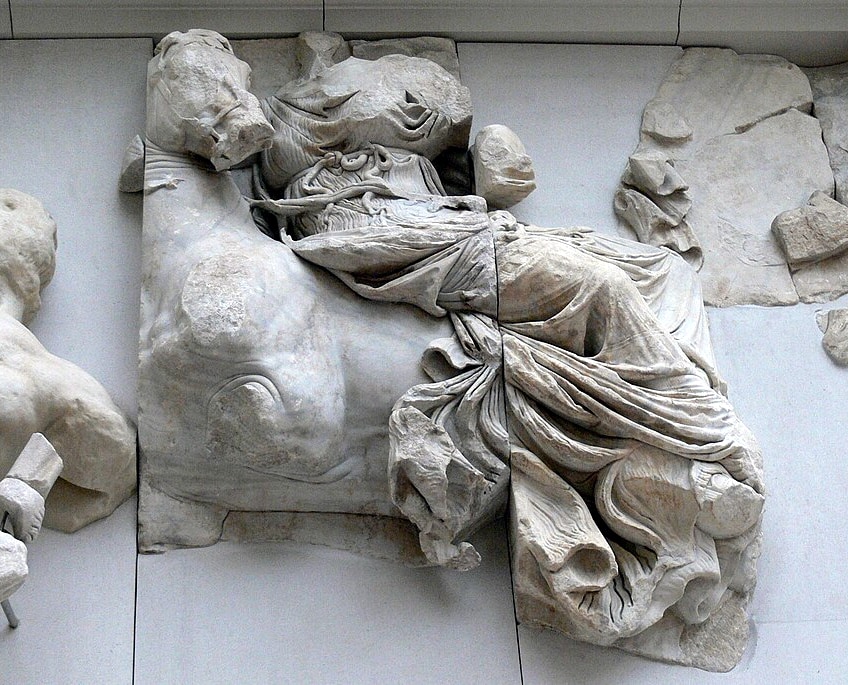 Detail from the frieze on the Great Altar at Pergamon showing Eos astride on horseback during the Gigantomachy (2nd Century BCE); Wolfgang Sauber, CC BY-SA 3.0, via Wikimedia Commons
Detail from the frieze on the Great Altar at Pergamon showing Eos astride on horseback during the Gigantomachy (2nd Century BCE); Wolfgang Sauber, CC BY-SA 3.0, via Wikimedia Commons
Aside from her bringing light and chasing the nocturnal mists away, she is also considered to be the origin of dew, which she pours out of jugs or vases along her way. This links her with her sister Selene who is sometimes thought to be the mother of Herse, the goddess of nourishing dew personified.
Bearer of the Stars and Winds
Eos is not just the dawn personified but the mother of the Anemoi, or the directional winds, and the Astra, or the stars in the heavens. She is the mother of Eosphorus, the dawn-star who goes before her and heralds her arrival, and the goddess Asteria who is the Virgo constellation. The winds and stars often held seasonal connotations.
The Anemoi for instance, particularly Boreas, Euros, Notos, and Zephyros, are also associated with the seasons; having connotations with the frigid winter, the autumnal season, the breezes of spring, and the stormy summer, respectively.
The stars in their motions were often used to calculate things like diurnal, seasonal, and religious festival cycles. They were also used for navigations, and were believed to hold messages of divine will for mankind. Eos, while being a crucial player denoting the beginning of the day since the beginning of ancient Greek cosmogony, is also a vital genealogical origin point for some of the most recognizable and influential forces of nature and divine will known to the ancient Greeks.
Dawn: The Lady in Love
Eos is a goddess who is characterized by her sexual appetite, with her mythos and popularity in poetry revolving around her pursuit of mortal lovers. Her love-lust is considered an inheritance from her Proto-Indo-European precursor and surfaces in other goddesses like Aphrodite.
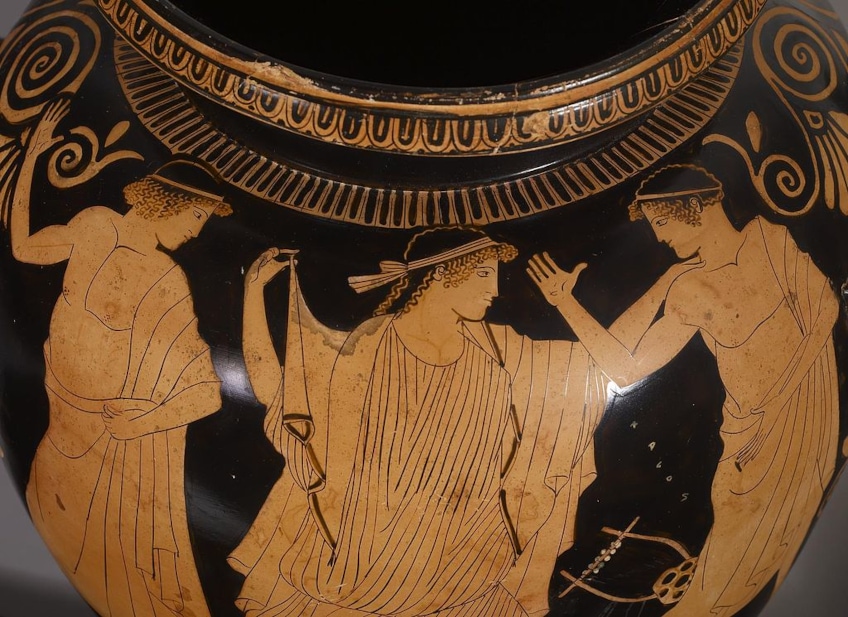 Red-figure stamnos with a depiction of Eos and two young men (5th Century BCE); Walters Art Museum, Public domain, via Wikimedia Commons
Red-figure stamnos with a depiction of Eos and two young men (5th Century BCE); Walters Art Museum, Public domain, via Wikimedia Commons
The intensity of Eos’ lascivious pursuits has been attributed by some to a curse placed upon her by Aphrodite. Apollodorus (2nd century CE) writes this was done in response to Eos sleeping with Ares, the god of war and Aphrodite’s lover. This the goddess of love cursed Eos to always be held in love and began Eos’ many dogged pursuits of handsome young mortal men. Her lovers include mortals such as Orion, Tithonus, Cephalus, and Cleitus.
She is also characterized as the reluctant dawn, being slow to leave her bed and lovers to bring light to mankind. However, her affairs usually ended sadly.
One of the myths surrounding the hunter Orion has Eos carry him off to the island of Delos, however, for uncertain reasons the goddess Artemis killed Orion in jealousy. Little is known about Cleitus other than he was a son of Mantios and his great looks drove Eos to snatch him away to place him amongst the immortals. Eos also took the Athenian prince, and son of the Olympian god Hermes, Cephalus as a lover. He was a hunter and musician of great beauty, and either engaged or already married to a woman named Procris. Despite the goddess’ best efforts, the young man declined her love. Eos then tried to sow discord between the couple, her machinations resulting in Procris feeling to Crete. Although Cephalus and Procris are eventually reunited, consumed by suspicion, she followed him on his early morning hunt, where he mistook her rustling the bushes for a beast and threw his javelin, striking and killing her.
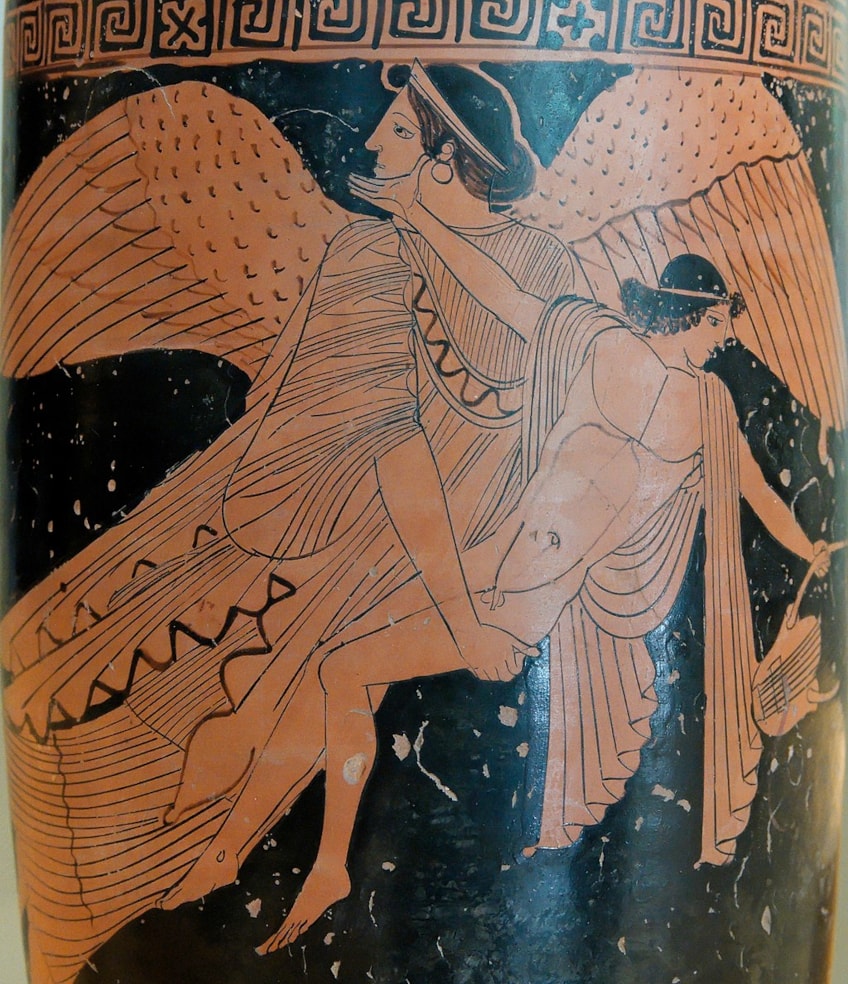 Attic red-figure lekythos with a depiction of Eos abducting Cephalus (470-460 BCE); National Archaeological Museum, CC BY 2.5, via Wikimedia Commons
Attic red-figure lekythos with a depiction of Eos abducting Cephalus (470-460 BCE); National Archaeological Museum, CC BY 2.5, via Wikimedia Commons
Tithonus is one of the most popular of Eos’ affair stories. Eos took a reluctant Tithonus from Troy to be her lover, though the Homeric Hymn to Aphrodite (7th – 8th century BCE) adds to their tale a tragic fate. Eos, perhaps wizened by her current enthrallment or the ends of her previous loves, pursued immortality for her Trojan prince. Eos requested this boon of Zeus, or in later writings Tithonus himself did, and it was granted. Crucially though, the request was for immortality with no mention of agelessness. So Tithonus could not die, however he continued to age and wither, until he was unable to move at all. Some versions have Eos abandon Tithonus to his endless torment in some forgotten room, while others maintain that she faithfully accompanied him.
 Aurora (Eos) and Tithonus by Auguste Rodin (1905 or 1906); National Gallery of Art, CC0, via Wikimedia Commons
Aurora (Eos) and Tithonus by Auguste Rodin (1905 or 1906); National Gallery of Art, CC0, via Wikimedia Commons
An addition to this myth is that Tithonus was turned into a cicada, considered a musical insect that seems most noisy around the early morning such as near dawn. There is an association of renewal and deathliness to insects that shed their skin, and the high-pitched voices of older men are likened in the Iliad (8th century BCE) to cicada’s song. The cicada is thus a creature associated with Eos.
A Mother of Mortals
A lovelorn goddess, she is also a mother to mortal children through her lovers. While her children with her husband Astraeus are immortal, her mortal children, much like her mortal lovers, often suffer tragic ends. Emathion, the king of Aethiopia and son of Tithonus and Eos, was killed by Herakles (Hercules) during his journey to retrieve the golden apples of the Hesperides during his Labors. The title of king then went to his brother Memnon, who allied with Troy during the Trojan War. A martial equal of the legendary Achilles, a son of the goddess Thetis, he was challenged in revenge for the death of Nestor’s son Antilochus.
Both Eos and Thetis pleaded with Zeus on behalf of their sons, however, Memnon was decreed to be the loser despite Achilles being fated to die soon after.
Eos’ grief over Memnon’s death was great. Three general mythic traditions detail what happened next. One holds that Eos caused the early appearance of night so she could spirit his body from the battlefield in the darkness. Another says she then implored Zeus, who was moved by her tears, to make Memnon immortal. Another myth explains the origins of the Memnonides birds, by saying that Memnon’s grieving men gave him a grand and luxurious funeral and were turned by the gods into birds. These birds are also considered by some to be sacred to Eos as well.
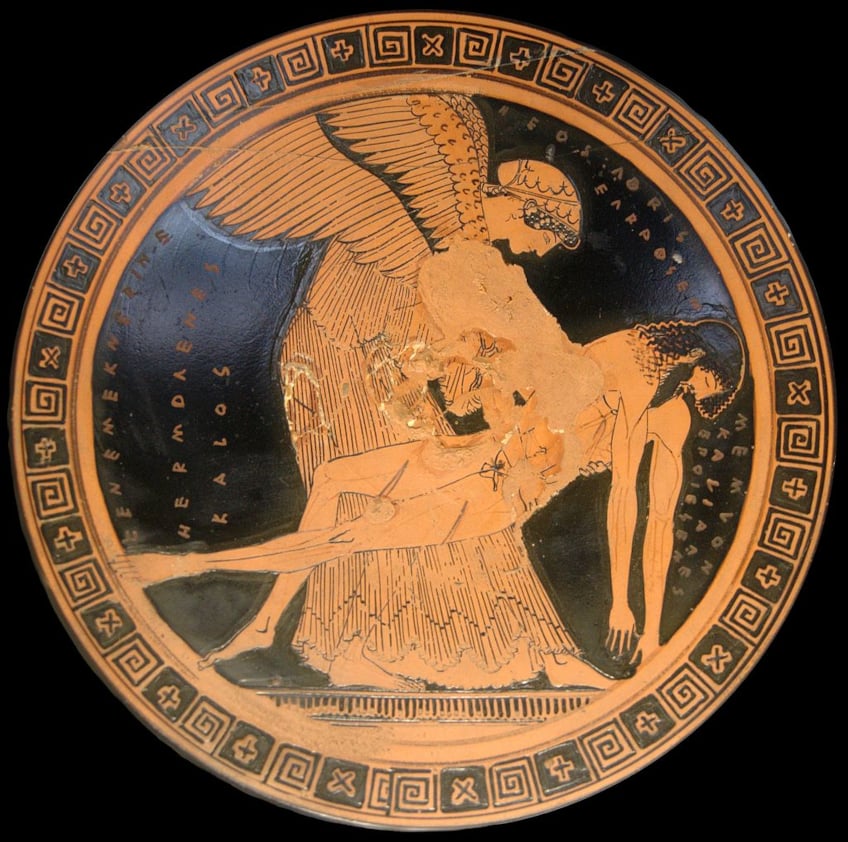 Attic red-figure cup with a depiction of the grieving Eos lifting the corpse of her son Memnon (c. 490-480 BCE); Louvre Museum, Public domain, via Wikimedia Commons
Attic red-figure cup with a depiction of the grieving Eos lifting the corpse of her son Memnon (c. 490-480 BCE); Louvre Museum, Public domain, via Wikimedia Commons
Phaethon has several possible identifications in Greek mythology. As the son of Eos and Astraeus, he is listed as the god of Dios, one of the Astra Planeta, or the “wandering stars”, associated with Jupiter. As one of the planets, he is alternatively known as a son of Helios who Zeus struck down when he lost control while driving his father’s sun-chariot. Phaethon, as the son of Eos by either Tithonus or Cephalus, is carried off as a child by Aphrodite to serve in her holy temple as a divine spirit or star guardian.
Modern Influence
Eos most notably continues her role as a figure of art throughout the Renaissance period, from the 14th to 17th century, and beyond. Swapping red-figure pottery for frescoes, paintings, and statues, Eos is a favored subject of art as constantly as the dawn itself is admired.
The prevalence of both the dawn itself and Greek mythology throughout the modern era means Eos is an enduring influence in one form or another.
The tragedy and scandal of doomed and obsessive love is a universal fascination that will see her myths continue to be relevant. In more recent times she has lent her name to 221 Eos, a large asteroid in the belt found between the planets Mars and Jupiter, christened at a Viennese observatory opening ceremony in hopes of a new dawn for astronomy in the country.
The Lessons of the Greek Goddess of Dawn
Eos is above all a tragic goddess of passionate personality, and her myths speak to the delights and dangers inherent in both passion and divine dealings. Whether she is fickle or faithful, or her conquests are consensual or not, the depths of Eos’ ardor is central. Eos shows that deep passions are a double-edged sword, with Eos’ love being covetous in concept but in practice often goes too far and ends in tragedy.
Feeling deeply is not wrong, and in fact has many positives in all aspects of your life, but obsessive and selfish pursuit of those feelings is often disastrous for all involved.
Simultaneously, references to her myths smack of the perils and fickleness of divine attention, from Aphrodite’s curse to the various mortal myths plucked from their lives for the sole crime of being bright enough to catch her eye. Eos’ dogged pursuits often ended in their untimely demise, and the reckless greed of seeking immortality unlocked a fate worse than death for Tithonus. Eos is thus a figure of warning, both of the helplessness of mortals before the powers of the capricious divine, and the dangers our own self-indulgence can bring.
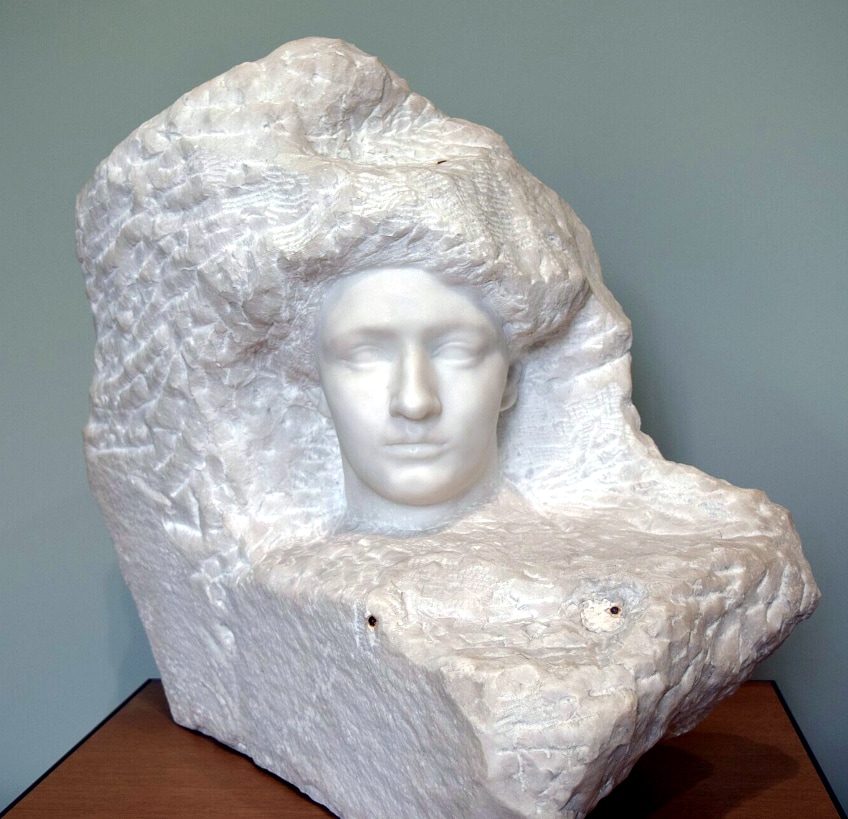 Aurora (Eos) by August Rodin (between 1895 and1897); Omar David Sandoval Sida, CC BY-SA 4.0, via Wikimedia Commons
Aurora (Eos) by August Rodin (between 1895 and1897); Omar David Sandoval Sida, CC BY-SA 4.0, via Wikimedia Commons
The goddess’ passion has placed her in the halls of legend, however, her passions are the source of her recklessness as she pursues them to the exclusion of all else and far too fast for good sense. Even in the most positive portrayals of her loves, her preoccupation with them makes her slow to perform her duty as the dawn to chase the night from the world and bring light to mankind. The Greek goddess Eos is a figure noting both the tragedy that befalls those who anger powers that be, as well as the importance of balancing passion and logic, delights and duty, and our own wishes versus the rights of others.
Eos, despite her tragedy and reluctance, also fulfills the dawn as a symbol of endless renewal.
The light of dawn is hopeful and damning in its inevitably for us and for the goddess of the dawn. No matter the delay or darkness, she must inevitably take to the sky and open the gates for the new day. Whatever her feelings, she is blessed and cursed to the certainty of a new day, a next love, or another opportunity. It can be said that Eos savors the nights with her loves, and beyond her reluctance to part, fulfills her duties in eager anticipation of returning to them. Life goes on, and stops for no mortal or goddess for long, so spend your time on earth as passionately and driven as Eos herself does.
The Greek goddess Eos is the dawn personified and a figure of much art and literature since Proto-Indo-European times. Eos is a goddess known for birthing the stars and winds, and is famous for her determined and doomed love affairs. She serves as a dramatic and tragic warning of the dangers of gods and love alike, the latter of which will remain as relevant to modern audiences as they were to the ancient Greeks. We hope you have enjoyed exploring this radiant and passionate persona of Greek mythology with us!
Frequently Asked Questions
What Are the Symbols of the Greek Goddess of Dawn?
As the personification of dawn, Eos has no celestial bodies or symbols directly dedicated to her. However, in reference to her depictions and descriptions in art, she is most directly associated with her saffron robe, her two-horse chariot, and flower and tiara iconography. She is also associated with the jugs of dew she is said to carry, gold and rose colors, as well as cicadas and Memnonide birds.
What Was the Role of Eos in Greek Myth?
Eos was the personification of the dawn to the ancient Greeks. She would end the night by bringing light to the world and opening the way for her brother Helios, the sun god, to begin his journey across the heavens. She was also the mother of the stars, the directional winds, and several demi-god figures of Greek mythology like King Memnon who fought in the Trojan War. Eos was a popular subject in art and literature for her love and kidnapping of handsome mortal men.

I am deeply passionate about history and am constantly fascinated by the rich and complex stories of the past. As the editor-in-chief of learning-history.com, I have the opportunity to share this passion with a wide audience through the creation and distribution of engaging and informative content about historical events, persons, and cultures. Whether it’s through writing articles and blog posts or creating videos or podcasts, I strive to bring the past to life in a way that is both accurate and enjoyable. My expertise in history, combined with my strong writing and communication skills, allows me to effectively communicate complex historical concepts and make them accessible and interesting to a wide range of readers. I am truly grateful for the opportunity to share my love of history with others through my work on learning-history.com.

